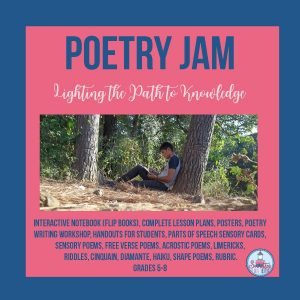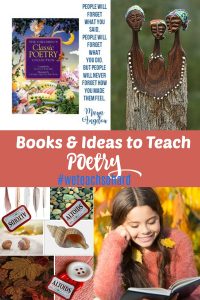
Since April is poetry month and my buds from our We Teach So Hard podcast and I, love poems, we’ve decided to share some of our faves with you for our monthly book series, and give you some ideas that you can use right away with your students.
Ever been afraid of things that go bump in the night, like the howling wind, or shadows on the wall, or a tree branch knocking against the window pane? When I was a child all snuggled in bed, I really hated getting up to go to the bathroom in the wee hours of the night because I was afraid that the monster under my bed would bite my feet. When I think about that it brings a smile to my face, ahhhh childhood!!! I remember watching a show where a child was pulled into the wall by a scary thing. All his parents heard was him calling them from the other side. The story ended well, he was saved and the monster was killed.
I came across a wonderful little poetry book called Life Doesn’t Frighten Me, by Maya Angelou which addresses the fears of childhood. I adore Maya, I’m sure many of you do also. This lovely catchy poem is written from a child’s point of view, you can just picture a little one lying in bed hearing sounds and looking at the wall and ceiling seeing strange shapes, some of them frightening.
Shadows on the wall
Noises down the hall
Life doesn’t frighten me at all
The message for the kids is that they can conquer their fears because they have the ability to take on life’s challenges come through with flying colors. We don’t have to let our fears get the better of us.
I go boo
Make them shoo
I make fun
Way they run
I won’t cry
So they fly
I just smile
They go wild
Life doesn’t frighten me at all.
This stanza is so powerful because this young girl has convinced herself that nothing life throws at her will truly frighten her. Courage will prevail.
Don’t show me frogs and snakes
And listen for my scream,
If I’m afraid at all
It’s only in my dreams.
I’ve got a magic charm
That I keep up my sleeve,
I can walk the ocean floor
And never have to breathe.
Here are some activities you can do with your class to help them gain a better understanding of the author’s intentions.
- Before reading the poem, begin a discussion of things that are scary and things that aren’t.
- Show them the book and take a look at the illustrations. Let them know that the illustrations are symbols, ask them what they think the symbols mean.
- Read the poem once. Read it again and ask them to close their eyes and picture the images that Angelou is talking about.
- Find out what types of images they pictured in their minds.
- Ask why Jean Michael Basquiat used symbols instead of actual pictures.
- Talk about the mood.
- Discuss how she deals with her fears
- Discuss what she has up her sleeve to stop her from being frightened and what can they do to stop from being afraid of things.
- Let them know that we all have things that frighten us but it’s important to overcome them.
- Have the class write a poem using sensory words about things that frighten them and how they can shoo away their fears. Illustrate their poems by using symbols like Jean Michel-Basquiat in Life Doesn’t Frighten Me. Make a booklet with an illustrated cover page.T
The next book I’d like to share is called The Children’s Treasury of Classic Poetry compiled by Nicola Baxter and illustrated by Cathie Shuttleworth. Filled with wonderful poems by some of our most treasured authors like Alfred Lord Tennyson who wrote “The Owl,” Robert Lewis Stevenson’s “The Swing,” Edgar Allen Poe’s “Eldorado,” William Blake’s “The Tyger” to name a few; this charmingly illustrated collection of treasured classic poems will delight your students as it still does to me. When I looked at Stevenson’s,
- Before hand, choose a few poems to read. Make copies for your kids.
- Since your students, more than likely will not be familiar with some words in the poems, give them a vocabulary list. Have them find the word meanings online or in a dictionary. Discuss
- Tell them they’ll be looking for figurative language in the poems. Make sure they understand what alliteration, personification, similes, metaphors, etc. are.
- You read the poem aloud, then read the poem together as a class. Next let kids read stanzas individually, or have different sections of your room read certain stanzas.
- Talk about the meanings of the poems and find similes, etc.
- Break into collaborative groups and write a group poem using alliteration, personification, onomatopoeia, personification, metaphors.
- Each group chooses a person to read the poem while the rest of the kids in the group act it out.
- As a final activity, play some classical music and have your class write free form poems about the images they envision as they listen to the melodies and rhythms. Have them illustrate their poems.
🌈Deann
Speaking of Poetry…Here’s a resource that I’ve created…Just click either image.
Be sure to visit Kathie, Retta and Tracy’s blog posts from We Teach So Hard for more inspiring tips and ideas about the many ways to use poetry in your classroom. To listen to our podcast on iTunes click HERE or the image below.
Retta @ Rainbow City Learning
Tracy @Wild Child Designs
Kathie @ Tried and True Teaching Tools
Deann @ Socrates Lantern




Leave a Reply